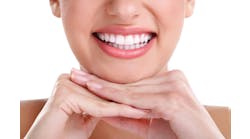The role of power toothbrushes in preventing implant failure
by Lisa C. Wadsworth, RDH
As “masters” of co-discovery with our patients and partners in co-therapy with our dentists, it is our professional responsibility to understand and embrace implant technology and maintenance. Our position of influence in our profession will increase dramatically when we feel confident to address the clinical and maintenance questions posed by our patients.
The objective of this article is to share my excitement over the proven success of power brushes and dental implants. The use of power brushes, whether electric oscillating or ultrasonic, can play a sound role in the successful maintenance of dental implants.
Twenty-two years ago I started to learn about the emerging technology of dental implant therapy, first as a patient, followed by a personal success story, then as a hygienist with a mission.
For me, implant dentistry has become a passion with a personal goal. It is growing faster than any other segment in dentistry, and the suggestions for treatment planning and subsequent maintenance are being revised at a confusing, almost dizzying rate.
Patients are bombarded with more information about maintenance every year. As hygienists, we are experts in helping our patients keep their dentition or implants healthy and their surrounding gums “in the pink.” We must be acutely aware of how to maintain what constitutes full dentition (implants or natural dentition).
While attending my first Association of Dental Implant Auxiliaries (ADIA) meeting, I learned that “Dental implants are the most natural replacement for a lost or missing tooth.” Use this statement when you work with your patients.
It has been said that “the most valuable asset we possess is our smile,” which defines us and provides us with our identity. We greet the world with our smiles! Quite frankly, the beauty of our smiles can either boost or crush our self-esteem and confidence. Why else would our population spend billions of dollars a year on cosmetic and implant dentistry?
The last paragraph might lead you to two assumptions. First, all patients are aware, focused, and participating in their home care regime as directed, and second, all patients floss, brush, and visit their hygienists every three to six months as recommended. Do you agree with my hypothesis? NOT!
Our responsibility to patients when we examine their maintenance needs following implant therapy is twofold — determine what caused the patient to have missing teeth (periodontal disease, trauma, genetics), and determine how important to the patient is maintaining the health of his or her investment. The motivation of one patient may not fit the needs of another.
I believe the maintenance for dental implants should be discussed during treatment planning. Successful implant maintenance is time consuming. If patients do not receive enough education about implant maintenance, they cannot fully understand or make appropriate decisions about their care.
When we suggest the electric brush as part of home care aids, we should review the difference between natural dentition and dental implants. Natural dentition has a periodontal ligament and 13 Sharpy’s fibers that support the gum tissue and protect the sulcus from bacterial invasion. A dental implant does not have any of these anatomical features. It does not have a periodontal ligament, but a perimucosal seal (a thin band of tissue with one horizontal fiber running around the circumference), and the gum tissue may or may not have the complement of keratinized tissue. These two differences before all others, such as bacteria, restorative design, or the number of implants, will influence which electric/sonic brush I select.
Dental implants must be maintained more diligently than natural teeth due to the factors listed above. Implants and the surrounding tissue are subject to the same bacterial invasion as natural dentition. Just as the gingiva surrounding natural dentition can experience gingivitis, so can the tissue around implants. We just use a different term. Gingivitis that affects the soft tissue around an implant is called peri-implant mucositis. This is defined as reversible inflammatory reactions in the soft tissues surrounding a dental implant exposed to the oral environment, with no bone loss (Glossary of Implant Dentistry II). Peri-implantitis surrounding dental implants is the term for inflammatory reactions in the hard and soft tissues, with loss of supporting bone.
I am an avid fan of powered toothbrushes. My top three are Rotadent, Oral-B, and my personal favorite, Sonicare. All are safe for use around dental implants. I believe in and use a sonic brush in my own mouth.
By selecting a powered brush over a manual brush, I am confident that patients who lack the motivation to do a competent job, or are challenged by physical conditions such as arthritis, will be able to properly maintain their implants.
Remember, although dental implants are now approved for use in children (under specific clinical guidelines), most of the people who have dental implants are over age 40. With age may come some form of disease process or physical limitation.
- Power brushes are successful in preventing implant failure.
- Power brushes create less friction while providing better plaque removal.
- Do your own professional research.
- Know the agents that can be used with your brush choice.
- Spend time educating your patients on the success of power brushes.
What to look for and why
Brush head
Final restorations often leave patients with difficult spaces to clean. I want more than one choice for my brush head. To date, a very small head shaped like a conventional brush has given me the best results.
In choosing a brush head for your patients, you should choose one that will maximize cleaning of the flat surfaces, and that will carry the chosen toothpaste/gel or fluoride into the interproximal spaces.
Read the literature on your selected brush to ensure that a nonabrasive toothpaste/ gel or fluoride paste/liquid can be safely used with your selected brush head. Some powered brushes recommend using no agents.
Bristles
Softer is better. Do not scrimp when purchasing your brush head because the bristles are very important. I recommend staying away from the inexpensive bristles because the quantity of bristles per head is usually less and the quality control is not as vigorous.
Remember — never use whitening or abrasive toothpaste when cleaning implant surfaces, no matter how soft the brush. I personally prefer a gel or fluoride rinse. Replace all brush heads every three months (sooner if you see an outward bend) and after recovering from a cold or flu.
Sonic or oscillation?
Do your research. Ask the companies you are interested in to provide a lunch-and-learn. Ask these questions:
- May I have copies of literature for my patients to support my decision?
- Does your literature support the use of the brush around implants?
- Is it easy for the patient to purchase the brush?
- How far interproximal will the brush displace my therapeutic gel or fluoride?
- How easy is it to keep the brush clean?
- Does the brush come with a self sanitizer?
- Can the entire brush be submerged in water?
- What do the replacement heads cost and where can they be purchased?
Lisa C. Wadsworth is a lecturer and president of Lisa C. Wadsworth Inc., a dental hygiene consulting company focused on the integration of advanced hygiene therapy, implant dentistry, and the improvement of communication skills that lead to the acceptance of highly technical treatment plans. She can be reached at (215) 262– 6168 or [email protected].





